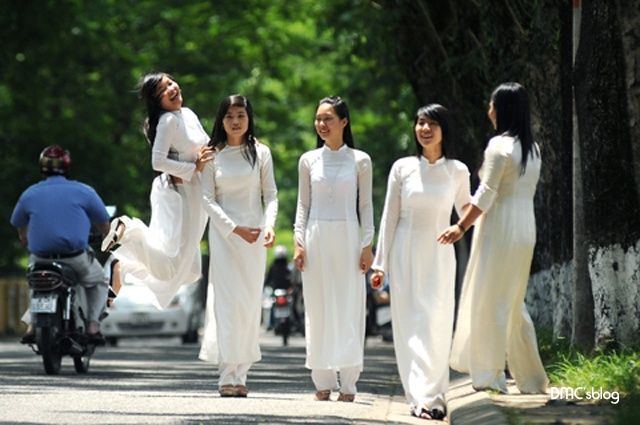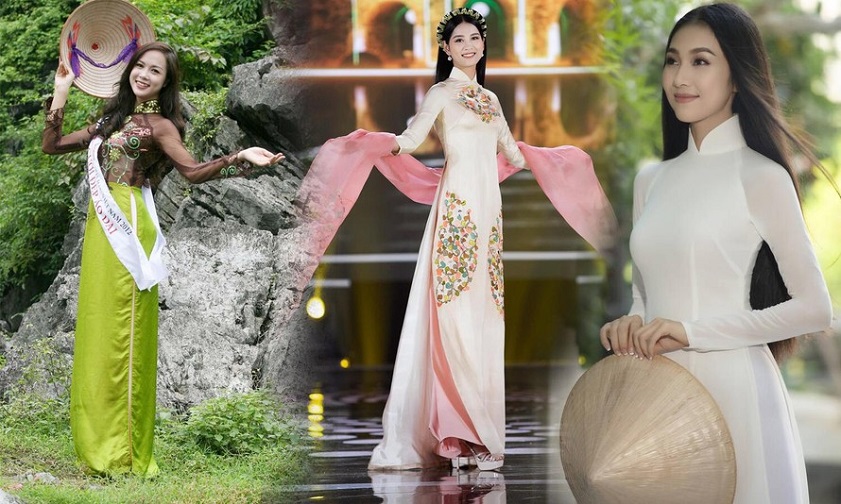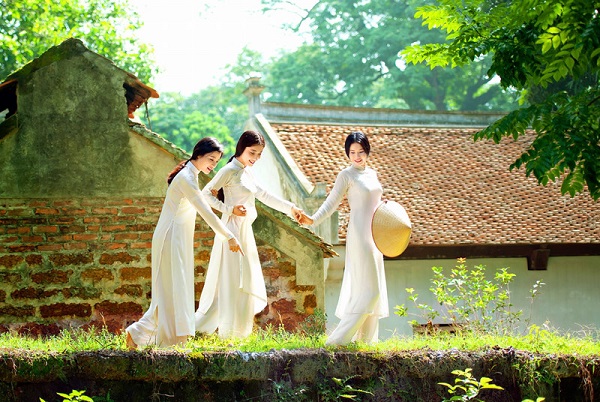Vietnam’s Ao Dai Takes the Spotlight at Columbia U

When the elegance of Vietnam’s áo dài graced the Revson Plaza at Columbia University, it was more than a fashion show. It became a cultural moment — where heritage, identity, and stories woven into silk took center stage amid an international audience. Vietnam’s áo dài took center stage at Columbia University cultural show, emerging not just as a piece of clothing, but as a living representation of Vietnamese hearts, history, artistry, and diaspora connections.
This vibrant showcase was part of “The Journey Connecting Heritage: Celebrating Vietnamese Culture through Arts and the Áo Dài,” organized by Columbia’s Global Vietnam Studies division and the Weatherhead East Asian Institute in collaboration with Vietmode. At this event, the áo dài was not just displayed, but celebrated—through conversation, craftsmanship, and a runway that fused tradition with contemporary design.
In this article, we will explore how Vietnam’s ao dai took center stage at Columbia University cultural show. We examine the historical roots of the áo dài, the modern reimaginings, why its appearance at a U.S. university matters in terms of cultural diplomacy, and the lasting resonance of this moment. Through detailed sections and vivid storytelling, readers will gain a rich understanding of both the garment and the broader cultural dialogue it embodies.
The Historical Legacy of the Áo Dài
Origins and Evolution of Vietnam’s National Costume
Before we see how the ao dai premiered at Columbia, it’s vital to grasp its storied past. The áo dài is a modernized Vietnamese national garment, typically a long tunic worn over silk trousers. Its evolution spans centuries of Vietnamese history, social change, foreign influence, and aesthetic reinvention.
Its roots lie in the older áo ngũ thân, a five-panel garment from the 19th century, which gradually transformed in silhouette and construction. In the early 20th century, visionary designers like Nguyễn Cát Tường (aka Le Mur) reshaped the áo dài into a sleeker, form-fitting design influenced by French tailoring. Over subsequent decades, the dress deepened its significance—becoming a symbol of feminine grace, national identity, and cultural continuity. The áo dài’s lasting presence in Vietnamese weddings, school uniforms, formal events, and contemporary fashion underscores its continual reinvention.
Symbolism and Cultural Resonance
More than fabric and form, the áo dài carries symbolic weight. It embodies Vietnamese identity, elegance, modesty, and resilience. Over time, it has been imbued with political and historical resonance—worn during colonial period resistance, wartime era transitions, and postwar revival. For many overseas Vietnamese, the áo dài evokes nostalgia, homeland memory, and a tangible link to cultural roots. Its visual frame—flowing silk panels, high collars, delicate embroidery—makes it a living canvas of Vietnamese aesthetics and values.
Given this layered history and symbolism, the decision to place the áo dài at the heart of a cultural show at Columbia University was not incidental—it was a deliberate gesture of cultural diplomacy and identity affirmation.
Planning and Purpose: The Columbia Cultural Showcase
Concept and Collaboration
Columbia University’s “Journey Connecting Heritage” event was conceived to commemorate 30 years of U.S.–Vietnam reconciliation and to display Vietnamese arts, crafts, and cultural heritage—anchored by the áo dài. By merging academic inquiry with artistic presentation, organizers aimed to bridge communities, spark dialogue, and position Vietnamese cultural heritage on a global stage.
Crucially, the event brought together designers, scholars, artisans, and students. The highlight was a conversation with Minh Hanh, a leading Vietnamese fashion designer, paired with a live runway performance of her contemporary áo dài designs. Through these intersecting voices, the showcase modeled how tradition and innovation can blend, and how cultural narratives travel across borders.
Venue, Audience, and Atmosphere
Held at Revson Plaza on Columbia’s campus, the event invited both the university community and the public at large. The open plaza setting allowed passersby to engage, offering a blend of intimacy and spectacle. The visual impact of flowing silks, traditional motifs, and the rhythms of storytelling activated the space.
Audience composition ranged from students and faculty in East Asian studies, fashion enthusiasts, Vietnamese diaspora visitors, to local New York City residents. The cultural show was positioned not merely as entertainment, but as an educational and diplomatic gesture. It invited attendees to experience the áo dài not as an artifact behind glass, but as a living, dynamic form of cultural expression.
How Vietnam’s Ao Dai Took Center Stage

The Runway Performance: Tradition Meets Innovation
At the heart of the showcase was the runway performance, where traditional and modern áo dài designs came to life. Minh Hanh’s creations merged classic textile techniques—silk weaving, embroidery, motifs—with contemporary silhouettes that resonate with a global fashion sensibility. The effect was to reclaim the áo dài as not just heritage costume but exportable art.
Models paraded garments that bore references to Vietnamese painting, nature, and folk art. The narrative arc of the show traced continuity between past and present: classic cut áo dài, then gradual modifications, and finally bold reimaginings that still retained core identity. In doing so, the performance justified the notion that the áo dài can evolve without losing its soul.
Craftsmanship Display and Artisans’ Stories
Beyond silhouettes and stanchions, the event gave space to silk weavers, embroiderers, and traditional artisans. Live exhibitions and installations showcased how the fabrics were made, how motifs were chosen, and how the meaning of patterns was preserved. The dialogue with artisans gave voice to those often unseen in garment production.
This was significant: viewers could trace how handwoven silk or native embroidery motifs flow from rural workshops in Vietnam into cosmopolitan stages abroad. It grounded the fashion spectacle in material, human, and regional roots. The presence of craftsmen reinforced that behind every áo dài lies a network of cultural transmission, technique, and pride.
Scholarly and Cultural Dialogue
Complementing the visual spectacle was a rich dialogue component. Minh Hanh and other artisans shared the philosophy, challenges, and choices behind their work. Questions spanned from the affordability of artisanal production, to balancing innovation with tradition, to how the áo dài can resonate abroad without cultural dilution.
By pairing academic lectures and conversations with aesthetic presentation, the organizers achieved synergy: the ao dai was not only worn, but interpreted, historicized, and debated. This dual approach underscored that the áo dài’s presence at Columbia was both fashion show and cultural symposium.
Why It Matters: Cultural Diplomacy Through Fashion
Building Bridges Between Vietnam and Diaspora
Vietnam’s áo dài taking center stage in Columbia University’s cultural show is a subtle but potent act of cultural diplomacy. In a university setting rich with global discourse, the garment embodied a bridge between homeland and diaspora. For Vietnamese Americans or international students with roots in Vietnam, seeing áo dài on stage in New York reaffirmed collective memory and pride.
For non-Vietnamese attendees, it offered access to Vietnamese narrative through a sensory and aesthetic medium. The show invited cross-cultural conversation and empathy. This is the power of fashion as diplomacy: garments become storytellers.
Reframing Stereotypes and Expanding Perception
In many Western contexts, traditional Asian dress is often exoticized or pigeonholed. But in this showcase, the ao dai was not a static “costume of the Other” — it was a living, evolving symbol. By presenting versions that are simultaneously respectful of tradition and boldly creative, the event reframes the way outsiders perceive Vietnamese culture.
The áo dài thus takes center stage not as a relic, but as proof that Vietnamese culture continues to speak, evolve, and innovate on global terms.
Educational Ripples and Long-Term Impact
At Columbia, students in Vietnamese studies, fashion, anthropology, or East Asian culture benefited by witnessing this living dialogue. The event may inspire curricular intersections—such as seminars on dress as identity, cross-cultural fashion, or heritage preservation through art.
Moreover, the public visibility of the áo dài on a major U.S. campus sets a benchmark. Other universities, cultural organizations, and diaspora communities may be encouraged to adopt similar models—interweaving scholarship, performance, and craft. The long-term ripple effect is that tradition becomes adaptive, rather than fossilized.
Challenges and Reflections
Balancing Tradition and Modern Appeal
One tension in presenting the ao dai at a cultural show abroad is preserving authenticity while appealing to global design tastes. Some purists might decry “excessive modernization” of the áo dài as losing its essence. Indeed, critiques have arisen when flamboyant, form-fitting, or provocative versions stray too far from traditional modesty. To counter that, curators and designers must make conscious choices about which elements to preserve and which to innovate.
At Columbia, the blend of traditional motifs, careful tailoring, and measured innovation struck a balance: the modern versions still referenced classic fabrics, collars, and motifs. This is a model for how the ao dai can remain true to itself while evolving.
Logistics and Cultural Translation
Transporting delicate silks and curated garments overseas demands care. Ensuring correct staging, lighting, and garment handling is no small feat. In addition, cultural translation matters: audiences unfamiliar with Vietnamese motifs or symbolism may miss deeper layers. Effective narration, program notes, and live explanations help bridge that gap.
Columbia’s integration of explanatory dialogue and exhibiting artisans helped mediate that distance—so that the show was both visually enchanting and intellectually grounded.
Ensuring Inclusive Representation
A further challenge lies in representing the diversity of Vietnamese culture through the áo dài. Vietnam is home to multiple ethnic groups with their own textile traditions, patterns, and aesthetics. A risk is presenting a monolithic Hanoi–Saigon view of the áo dài. Future efforts may expand inclusivity by showcasing minority textiles, regional variations, or hybrid styles to more fully reflect Vietnam’s cultural mosaic.
Looking Forward: The Ao Dai Beyond Columbia

Inspiring Future Cultural Exchanges
The success of this showcase may seed future collaborations at other universities, cultural centers, and fashion institutions worldwide. Imagine an ao dai exhibit at Smithsonian, at London’s V&A, or at West Coast U.S. campuses—each pairing scholarship, performance, and artisanship. The Columbia event sets a precedent.
Digital Legacy and Accessibility
Beyond the in-person event, documenting the show—through video, photography, virtual exhibits—ensures the cultural impact endures. Digital archives allow viewers globally to experience how Vietnam’s ao dai took center stage at Columbia. These resources become references for students, designers, and diaspora communities.
Inspiring Youth and Cultural Continuity
Perhaps most impactful is inspiring younger generations of Vietnamese and Vietnamese diaspora youth to connect with their heritage. When they see áo dài celebrated internationally, it affirms value. They may feel pride to wear áo dài at graduations, cultural nights, or fashion fusion events. In this way, the garment continues its life across borders and times.
Also Read: WhiteBIT Coin Price WBT Price Live Charts and Marketcap
Conclusion
Vietnam’s ao dai took center stage at Columbia University’s cultural show in a rich, multilayered celebration of heritage, identity, artistry, and diplomacy. Through runway performance, artisan storytelling, and scholarly dialogue, the showcase transformed the garment from object to narrative. It bridged homeland and diaspora, invited cross-cultural curiosity, and posed new ways for tradition to evolve.
While balancing tradition, innovation, and inclusive representation remains a challenge, the Columbia event offers a compelling model of how a national dress—rooted in centuries—can still resonate on a global stage. As fashion continues to interweave with identity and exchange, the áo dài will likely ride forward in new interpretations, new audiences, and new dialogues.
The legacy is alive: silk threads connecting Vietnam to the world, culture to conversation, and fabric to future generations. Vietnam’s áo dai taking center stage at Columbia University may be one moment—but its ripple may continue across years, art forms, and hearts.
FAQs
Q: What is the historical significance of the áo dài in Vietnamese culture?
The áo dài evolved from earlier garments like the áo ngũ thân, gradually transformed by modern designers like Nguyễn Cát Tường in the early 20th century. It became emblematic of Vietnamese modern identity, femininity, and national pride. Over time, it has functioned in politics, education, and cultural diplomacy, making it a profound symbol of Vietnamese heritage.
Q: Who is Minh Hanh, and why was she central to the Columbia event?
Minh Hanh is a celebrated Vietnamese fashion designer known for integrating traditional Vietnamese crafts—silk weaving, indigenous motifs, embroidery—into modern design. At the Columbia cultural show, her designs served as central visual anchors and she participated in conversations exploring the meaning, challenges, and global potential of the áo dài.
Q: How did Columbia University stage the áo dài to engage an international audience?
Columbia used a blend of runway performance, artisan exhibits, and scholarly dialogue. The visual show was complemented by conversations explaining motifs, techniques, and cultural context. By doing so, the ao dai was both seen and interpreted, making it accessible for audiences who may lack background knowledge.
Q: Are modern reinterpretations of the áo dài controversial?
Yes, sometimes. Purists may argue that extreme modernization dilutes the traditional aesthetic and modesty values of the original áo dài. Critics caution against over-sexualized or overly avant garde versions. The challenge lies in innovating while preserving the garment’s soul and cultural resonance.
Q: What is the long-term significance of showcasing the áo dài at such cultural shows?
The event helps preserve and project Vietnamese culture to new audiences, supporting heritage continuity and global dialogue. It can inspire similar exchanges, digital archiving, cross-cultural fashion studies, and diaspora pride. Ultimately, it ensures that the áo dài remains alive, evolving, and resonant far beyond borders.




